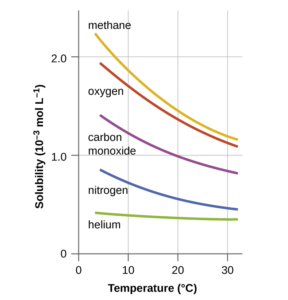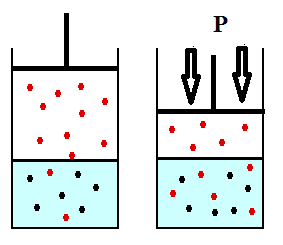Science > Chemistry > Solutions and Their Colligative Properties > Solutions of Gases in Liquids
In this article, we shall study solutions of gases in liquids and Henry’s law of solubility.
Almost all the gases are soluble in water as well as in other liquids to a greater or lesser extent. The solubility of gases in the liquid is expressed in terms of the absorption coefficient. The absorption coefficient is defined as the volume of gas in mL that can be dissolved by 1 mL of a liquid solvent at the temperature of the experiment at one atmospheric pressure. The volume of the gas is measured at STP. Mathematically
α = v/VP
Where, α = absorption coefficient of a gas
v = volume of gas dissolved in V volume of liquid solvent at atmospheric pressure P
Factors Affecting Solubility of Gases in Liquids:
Nature of Gas and Nature of Solvent:
- The gases which are easily
liquefiable (e.g. CO2) are relatively more soluble than dihydrogen
and dioxygen in common solvent. - The gases which are capable of
undergoing a chemical reaction with the water (e.g. HCl, NH3) are
relatively more soluble in water than other solvents. - Oxygen, nitrogen and carbon dioxide
are more soluble in ethyl alcohol than in water at the same temperature and
pressure.
Effect of Temperature:
The solubility of gases in liquids decreases with the rise in temperature. When dissolved, the gas molecules are present in the liquid phase and the process of dissolution can be considered similar to condensation and heat is evolved in this process.
We know that the dissolution process involves dynamic equilibrium and thus must follow Le Chatelier’s Principle. As dissolution is an exothermic process, the solubility should decrease with the increase of temperature.

From the graph, we can see that the solubility of oxygen in water decreases rapidly with the increase in temperature. This results in a condition called thermal pollution. Thermal pollution is defined as a sudden increase or decrease in temperature of a natural body of water which may be ocean, lake, river or pond by human influence. It is harmful to its living inhabitants as the oxygen content of water decreases.
Effect of pressure:
The solubility of gases in liquids is greatly affected by pressure and temperature. The solubility of gases increases with the increase in pressure.
For a solution of gases in a solvent, consider a system as shown in the following fig (a). The lower part is the solution and the upper part is the gaseous system at pressure P and temperature T. Assume this system to be in a state of dynamic equilibrium, i.e., under these conditions rate of gaseous particles entering and leaving the solution phase is the same.

Now increase the pressure over the solution phase by compressing the gas to a smaller volume. This will increase the number of gaseous particles per unit volume over the solution and also the rate at which the gaseous particles are striking the surface of the solution to enter it. The solubility of the gas will increase until a new equilibrium is reached resulting in an increase in the pressure of a gas above the solution and thus its solubility increases.
It is to be noted that the pressure does not have any significant effect on so the ability of solids in liquids. It is so because solids and liquids are highly incompressible and practically remain unaffected by changes in pressure. The effect of pressure on the solubility of a gas in a liquid is given by Henry’s law.
Henry’s Law of Solubility:
Henry was the first to give a quantitative relation between pressure and solubility of a gas in a solvent which is known as Henry’s law. The law states that at a constant temperature, the solubility (S) of a gas in a liquid is directly proportional to the pressure (P) of the gas.
S α P
∴ S = KP

Where K = Henry’s constant
When P = 1, then S = K
Thus the solubility of gas at unit pressure is equal to Henry’s constant.
Dalton, a contemporary of Henry, also concluded independently that the solubility of a gas in a liquid solution is a function of the partial pressure of the gas.
If we use the mole fraction of a gas in the solution as a measure of its solubility, then it can be said that the mole fraction of gas in the solution is proportional to the partial pressure of the gas over the solution. The most commonly used form of Henry’s law states that “the partial pressure of the gas in the vapour phase (p) is proportional to the mole fraction of the gas (x) in the solution” and is expressed as:
p = KHx
Where KH is Henry’s law constant.
If we draw a graph of the partial pressure of the gas versus mole fraction of the gas in solution, then we should get a plot of the type as shown.

Different gases have different KH values at the same temperature. This suggests that KH is a function of the nature of the gas. From the above equation, we can conclude that the higher the value of KH at a given pressure, the lower is the solubility of the gas in the liquid.
Applications of Henry’s Law of Solubility:
Henry’s law finds several applications in industry and explains some biological phenomena.
- To increase the solubility of CO2 in soft drinks and soda water, the bottle is sealed under high pressure.
- Scuba divers must cope with high concentrations of dissolved gases while breathing air at high pressure underwater. Increased pressure increases the solubility of atmospheric gases in the blood. When the divers come towards the surface, the pressure gradually decreases. This releases the dissolved gases and leads to the formation of bubbles of nitrogen in the blood. This blocks capillaries and creates a medical condition known as bends, which are painful and dangerous to life. To avoid bends, as well as, the toxic effects of high concentrations of nitrogen in the blood, the tanks used by scuba divers are filled with air diluted with helium (11.7% helium, 56.2% nitrogen and 32.1% oxygen).
- At high altitudes, the partial pressure of oxygen is less than that at the ground level. This leads to low concentrations of oxygen in the blood and tissues of people living at high altitudes or climbers. Low blood oxygen causes climbers to become weak and unable to think clearly, symptoms of a condition known as anoxia.
Limitations of Henry’s Law:
Henry’s law is applicable only under the following conditions.
- The pressure of the gas is not too high.
- The temperature is not too low.
- The gas should not undergo any chemical reaction with the solvent.
- The gas should not undergo dissociation in the solvent.
Henry’s Law is not strictly followed.
Higher Solubility than expected:
Ammonia not only dissolves in water but also reacts with it. The reaction is as follows.
NH3 + H2O →NH4OH ⇌ NH4+ + OH–
CO2 not only dissolves in water but also reacts with it. The reaction is as follows.
CO2 + H2O →H2CO3
In both cases, higher solubilities result than expected. Water is sparingly soluble in water but is highly soluble in the blood to the presence of haemoglobin of the blood.
Salting out effect:
Salting out is an effect based on the electrolyte-non electrolyte interaction, in which the non-electrolyte could be less soluble at high salt concentrations. Gases are less soluble in aqueous solutions of electrolytes. Similarly, sugar the non-electrolyte decreases the solubility of a gas in water.
Related Topics
Solutions and Their Colligative Properties
- Solutions and Their Types
- Solutions of Solids and Liquids
- Concentration of Solution
- Numerical Problems on Percentage by Mass and Volume
- Numerical Problems on Mole Fraction
- Numerical Problems on Molarity
- Numerical Problems on Molality
- Short Cuts For Above Numerical Problems
- Ideal and Non-ideal Solutions
- Lowering of Vapour Pressure
- Numerical Problems on Lowering of Vapour Pressure
- Elevation in Boiling Point and Depression in Freezing Point
- Osmosis and Osmotic Pressure
